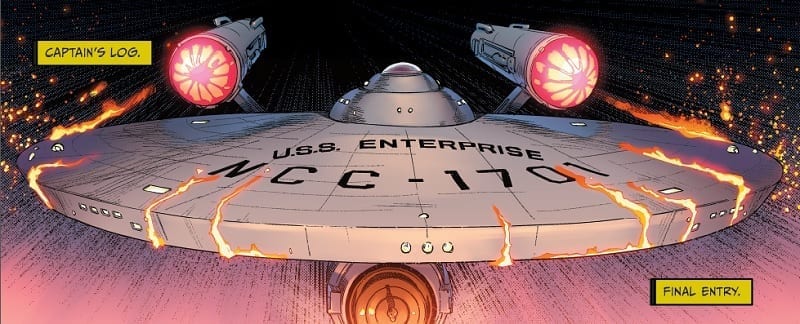Continuing their line of Star Trek comics, IDW Publishing asks the question, “What happened next?” In their new offering, Star Trek Year Five, the creators return to the original crew of the Enterprise and explore the final year of their original mission. Everyone knows what came after but where did the Enterprise go in that final, missing year?

Writing/Story
The crew of the star ship Enterprise have been exploring together for exactly four years. Their current mission provides then with a spectacular light show to accentuate their celebrations.
But as the crew celebrate Captain Kirk receives a communication containing news he doesn’t want and Lieutenant Uhura picks up a distress call from an uninhabited planet.
The most important job of a first issue is to hook a reader so that they will continue to come back month after month. For a lot of Star Trek fans that hook is in the title of this comic; Year Five. To witness the continuation of the original mission through to completion appeals to all fans of the original series.
And if the title wouldn’t do it the opening section of this comic would. Writers Jackson Lanzing and Collin Kelly open the comic with a panel showing the Enterprise, NCC-1701, burning up, under obvious distress with two caption boxes, two words each:
Captain’s Log. Final Entry
No matter what happens next that first panel has trapped you in the story. Those four words sends shivers down your spine, like hearing the words ‘Winter is coming’, they have an involuntary effect on the reader.
The first page is a jaw dropper packed with emotion but the reader will have to wait for a resolution because there is the fifth year to live through.
The rest of this issue is a set up for the series and the first mission in the Enterprise’s final year. There is a lot of exposition in the opening pages, which is littered throughout with continuity references. Lanzing and Kelly know the characters very well and capture their individuality in their speech. The cast of Year Five are the characters from the original series, down to a T. This isn’t an interpretation or re-imaging; this is Star Trek series 4.

Art
It is not only the story that captures the feel of the original Star Trek; the artwork also embraces the 1960’s aesthetic beautifully. The combination of Stephen Thompson’s pencils and Charlie Kirkoff’s colors is reminiscent of the Star Trek comics produced in late 1960’s and early 1970’s where Alberto Giolitti provided the artwork. The panels are dynamic with viewpoints that reflect the characters within.
Captain Kirk, for example, strides through a panel, his importance and presence cannot be restrained by the boarders or gutters of the page. Thompson gives the panel a low camera angle so that the readers look up to the captain in the same way as the crew. There are a number of character establishing panels throughout this first issue of Year Five and they show how much of an understanding the artists have for the cast.
The hardest job goes to Neil Uyetake who has to fit the massive amount of dialogue over Thompson and Kirkoff’s art. Luckily for Uyetake, the characters are the stars of this comic, not the sets, so he is able to position the speech balloons around the cast. On occasions this creates a claustrophobic feel to some of the spaces which helps to remind the reader that the original Enterprise was much smaller than later ships. The lettering gives the reader the impression of being trapped in a submarine rather than a luxurious star liner. This is a working ship, not a pleasure cruiser, and this point is illustrated by the packed panels and lack of open spaces.
It also provides a wonderful comparison to the away teams trip on the surface of Lloyd Zeta-9 because there is suddenly so much space. Large landscapes fill the page and the dialogue becomes less prominent.

Conclusion
Star Trek Year Five issue one states its intentions from the beginning and, throughout this issue, constantly reminds the reader that this is Original Series Trek. The characters are the ones we know and love. The sets have a 1960’s TV show aesthetic, so much so that you could believe that this comic was set on the sound stages of Paramount Pictures lot.
The entire art team work together to produce a single vision of this Star Trek universe, referencing not only episodes from the original series but also extended universe material, especially the comics style from the 1960’s.
And, of course, this comic has one big hook for the reader which captures you from the very first page. Once you start to read Year Five you will want to know what happens next; it is highly improbable that after issue one, anyone would miss issue two.

